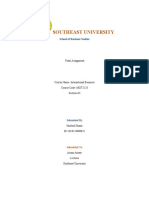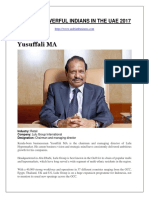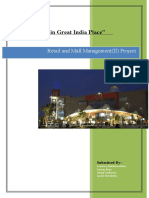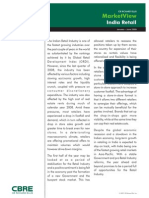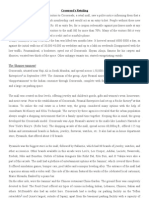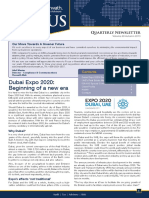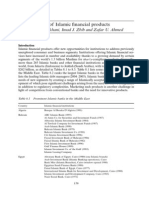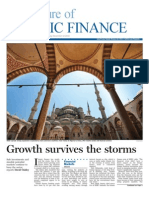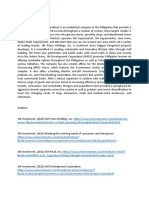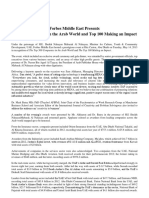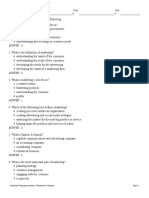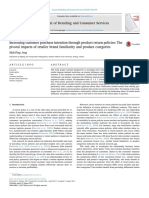Retail Gusher
Retail Gusher
Uploaded by
zehrars1Copyright:
Available Formats
Retail Gusher
Retail Gusher
Uploaded by
zehrars1Original Description:
Copyright
Available Formats
Share this document
Did you find this document useful?
Is this content inappropriate?
Copyright:
Available Formats
Retail Gusher
Retail Gusher
Uploaded by
zehrars1Copyright:
Available Formats
RETAIL GUSHER
SAUDI ARABIAS RETAIL SECTOR IS UnDERGOInG A MAJOR GROWTH SPURT
By Spencer Rumsey
A
50
SCT / N O V E M B E R 2 0 1 3
T NIGHT THE MALL OF ARABIA LOOKS LIKE A SPACESHIP about to lift off, with all those gleaming, translucent windows and its curving facade ringed by green and blue lights. The four-floor property, built by Arabian Centres Real Estate in 2008 in Jeddah, Saudi Arabias second-largest city, boasts some 300 shops and about 1.1 million square feet of gross leasable area. This makes it one of the largest malls in town though perhaps not for much longer, given what is now in the pipeline. Meanwhile, Saudi retail figures have been climbing. Retail sales grew by 25 percent year on year in the first quarter, according to Jones Lang
THE 1.1 MILLION-sQUArE-FOOT MALL OF ArAbIA, IN JEDDAH
LaSalle. The Economist Intelligence Unit values the retail sector at some $90 billion and says that could hit $139 billion by 2017. Saudi Arabia has roughly 20 percent of the worlds petroleum reserves in its eastern province. And the country has a young and affluent population that is eager to spend. Some 60 percent of the 30 million Saudi people are age 30 or younger. Salaries have jumped by about 55 percent between 2009 and 2012, according to HSBC, thanks in part to employment in the public sector and to a new minimum wage. Real GDP grew by 6.8 percent last year on high oil production and expansionary fiscal policies. Consequently, the signs of development are just about everywhere in Saudi Arabia these days. Jeddah, with its population of 3.8 million, has several big projects in the works. The total retail stock could grow from about 9 million square feet today to nearly 11 million square feet by 2016, according to Jones Lang LaSalle. The Flamingo Mall, which Castle House Investment & Real Estate Development built in the western part of the city on Prince Majid Road, is the newest to open. Jeddah-based SEDCO Development is planning to open the Galleria, on Tahlia Street in Jeddahs business district, later this year. This elegant building with classic stone columns, balustrades and arches is a combination luxury mall and five-star hotel, managed by the Elaf Group.
In the citys seacoast resort area, known as Jeddah Corniche, Zahran Real Estate Investment & Development Co. has been building the Lamar Towers, which will combine luxury housing with the high-end Lamar Mall. The project will comprise a 13-story podium containing the mall, a luxury spa, and a parking garage; twin glass towers, each providing a view of the Red Sea, will rise an additional 50 stories. Originally begun in 2007, the project languished until its restructuring and refinancing this year. The new completion date is 2015. Jeddah benefits from being a major gateway to Mecca, to which some 2.5 million Muslim pilgrims from around the world come on their hajj each year. The city itself is seeing new development with the opening of Arabian Centres Makkah Mall in 2011. Jabal Omar Development Co. has started work on a 24 million-square-foot project near The Grand Mosque, a project that will contain 38 hotels and reportedly become the largest shopping center in Saudi Arabia once it is completed in 2017. Riyadh, the capital city, with nearly 6 million people, has projects of its own that are now under way or nearing completion. Fawaz Al-Hokair, which owns Arabian Centres Real Estate, announced an aggressive expansion in that city. Besides its Al Nakheel Mall, set to open next year, the firm is planning to complete two additional major retail centers there: the Al Hamra Mall and the Malaz Mall. Fawaz Al-Hokair also says it hopes to build a Mall of Arabia in Riyadh in 2015, despite the existence of the one in Jeddah. Majid Al Futtaim, one of the most prominent development firms in the Middle East, anThe Economist nounced the possibility Intelligence Unit of a regional or superregional mall of its own values the Saudi in Riyadh. retail sector at some The most ambitious undertaking in Riyadh $90 million is the King Abdullah and says that could Financial District, a joint venture of the hit $139 billion Capital Market Auby 2017. thority and the Public Pension Agency, which will feature shops, palmtree-lined promenades along indoor waterways, sports fields under retractable roofs, a business school and a monorail on its 1.3 square-mile, teardrop-shaped site. This nearly $10 billion project, originally launched in 2006, is intended to help the kingdom consolidate its position as the Middle East financial capital. Tenants
N OVEM BER 2013 /
SC T
51
TAKING A FOOD COUrT brEAK
were expected to begin moving in this year, but response has been slow. Elsewhere the scale of malls seems to be shifting, according to Craig Plumb, head of MENA research for Jones Lang LaSalle. The emphasis will move toward small local centers as the major cities become increasingly crowded with major malls, he said. There is room for still more regional centers, he says. Indeed, Arabian Centres is looking at underserved smaller cities. We have been witnessing a shift in the development vision of the mall investors from poorly planned centers to a more sophisticated international retail development approach, said Phil McArthur, president of Dubai-based McArthur & Co., which handles development, leasing, operations and marketing for shopping centers in the region. Large suburban centers located on major arterial roads are now opening at a rapid pace. Its quite exciting to see the sales performance of the market. The disposable income
gains among the younger people and their increasingly demanding tastes are driving the retail expansion, he says. The trading dynamic in Saudi Arabia has been changing significantly in the last three to four years as international retailers have begun to discover that the core wealth, population density and consistency of business during any economic period is in fact in Saudi Arabia, said Simon Wilcock, CEO of Arabian Centres. Saudi Arabia is keeping up with the booming United Arab Emirates, at least when it comes to shopping, he says. There is very little difference in the nature of consumer habits between the Gulf states, he said, Only [in] what they have access to. Plumb says the current retail landscape is dominated by Western brands, but there is encroachment coming from Saudi names, as well as merchandise coming from China and India. Interestingly, these retail-spending gains are coming despite the religious
edicts of this conservative Wahhabi Islamic society: movie theaters and concerts are banned, and women are not allowed to drive and they must cover themselves from head to toe when they are out in public. None of this is keeping the ladies from shopping, though. Saudi women have no problem getting to the malls, as many have drivers or family members to take them, said McArthur, whose firm recently completed a 50-mall tour of the country to rate the best shopping centers on behalf of a major U.S. retailer. We noted the malls are extremely busy in the evenings, with families and women shopping like anywhere else in the world, he said. Another positive development he notes is that many Saudi women are employed in the retail sector as sales assistants and cashiers. And these retail workers are staying busy, to be sure. The malls are filled with young families and other shoppers eager to see what the world has to offer. SCT
NOVEM BER 2013 /
SCT
53
You might also like
- The Souled StoreDocument8 pagesThe Souled StoreRani DispotaNo ratings yet
- Marketing Exam 3 (Grantham)Document10 pagesMarketing Exam 3 (Grantham)aarond3No ratings yet
- International Business Case Study and Question AnswerDocument6 pagesInternational Business Case Study and Question AnswerHasibul Hasan67% (3)
- The Retail Industry in The GCCDocument13 pagesThe Retail Industry in The GCCNilgun EmremNo ratings yet
- Shopping OasisDocument4 pagesShopping Oasiszehrars1No ratings yet
- Dubai's Retail Sector Riding Tourism's WaveDocument6 pagesDubai's Retail Sector Riding Tourism's WaveJed HollenbeckNo ratings yet
- Final September RetailDocument4 pagesFinal September RetailKomal RainaNo ratings yet
- Retail Trends - Hypermarkets in 2006Document2 pagesRetail Trends - Hypermarkets in 2006smh9662No ratings yet
- Dubai RetailDocument12 pagesDubai RetailMarina PetrovaNo ratings yet
- Saudi Arabien Furniture Clothing and Design 2012Document6 pagesSaudi Arabien Furniture Clothing and Design 2012Ja JUOINo ratings yet
- Questionnaire On Employee MotivationDocument2 pagesQuestionnaire On Employee MotivationMuhd BasharNo ratings yet
- 50 Most Powerful Indians in UaeDocument51 pages50 Most Powerful Indians in Uaeanon_315729828100% (1)
- GCC Retail Industry Report 2012 - 9 December 2012Document80 pagesGCC Retail Industry Report 2012 - 9 December 2012aakashblueNo ratings yet
- Islamic Banking in The Middle EastDocument6 pagesIslamic Banking in The Middle EastHameed WesabiNo ratings yet
- E-Commerce in Saudi Arabia Driving The Evolution Adaptation and Growth of Ecommerce in The Retail Industry SOCG 2012june17Document26 pagesE-Commerce in Saudi Arabia Driving The Evolution Adaptation and Growth of Ecommerce in The Retail Industry SOCG 2012june17Hanan YoussefNo ratings yet
- Oil Trading Firms SeDocument3 pagesOil Trading Firms SeBoyang SunNo ratings yet
- " Retailing in Great India Place": Retail and Mall Management (II) ProjectDocument20 pages" Retailing in Great India Place": Retail and Mall Management (II) ProjectmavozzNo ratings yet
- Luxury in UaeDocument3 pagesLuxury in UaeDr. Firoze KhanNo ratings yet
- Mall Projects in MEDocument7 pagesMall Projects in MESiraj KuvakkattayilNo ratings yet
- Southern PropertyDocument24 pagesSouthern PropertyTimes MediaNo ratings yet
- TheWorld sRichectArabsDocument51 pagesTheWorld sRichectArabsMian Muhammad Shahid SharifNo ratings yet
- Vishal RetailDocument8 pagesVishal RetailHimanshu Singh SikarwarNo ratings yet
- Business Plan ProjectDocument4 pagesBusiness Plan ProjectMike RajasNo ratings yet
- GCC Retail IndustryDocument87 pagesGCC Retail IndustryHarzamir Bamore100% (1)
- World RetailDocument5 pagesWorld Retailloveshin17No ratings yet
- Emerging Destinations Challenge Traditional Global Hot Spots As Most International Retail CitiesDocument16 pagesEmerging Destinations Challenge Traditional Global Hot Spots As Most International Retail CitiessbasantNo ratings yet
- Case Study - CrossroadDocument3 pagesCase Study - CrossroadNaveed Ilyas100% (1)
- Giordano Middle East ExpansionDocument3 pagesGiordano Middle East ExpansionNasir MohammedNo ratings yet
- (Case 5) Al-Rajhi - The Saudi Arabia Kingdom's Glocal BankDocument14 pages(Case 5) Al-Rajhi - The Saudi Arabia Kingdom's Glocal BankRifky Rahmad FahrefyNo ratings yet
- International MarketingDocument23 pagesInternational MarketingManveer SinghNo ratings yet
- "Pride of The Shine": by EdelweissDocument52 pages"Pride of The Shine": by EdelweissDeepankar AzadNo ratings yet
- Lulu MallDocument12 pagesLulu MallDeepa SureshNo ratings yet
- Asian Cities BJ Retail 2h 2012Document4 pagesAsian Cities BJ Retail 2h 2012Yeo Shan RuiNo ratings yet
- Expo 2020Document4 pagesExpo 2020Saher SeherNo ratings yet
- Banking Finance Sectorial OverviewDocument15 pagesBanking Finance Sectorial OverviewOladipupo Mayowa PaulNo ratings yet
- Retail ReduxDocument4 pagesRetail ReduxArjun TrehanNo ratings yet
- Chalhoub Group White Paper 2013 EnglishDocument9 pagesChalhoub Group White Paper 2013 EnglishFahad Al MuttairiNo ratings yet
- LandmarkDocument5 pagesLandmarkapi-3716851No ratings yet
- Retail's Risky New StrategyDocument2 pagesRetail's Risky New Strategyabhishekkr26jNo ratings yet
- Select City Walk (Tarun)Document15 pagesSelect City Walk (Tarun)Tarun BatraNo ratings yet
- Saudi Arabia Fast FoodDocument2 pagesSaudi Arabia Fast FoodBilal FarooqNo ratings yet
- Sample Research Paper On Strategic ManagementDocument7 pagesSample Research Paper On Strategic ManagementTiffani PriceNo ratings yet
- Chapter 8 Marketing of Islamic Financial ProductsDocument12 pagesChapter 8 Marketing of Islamic Financial ProductsadilagidiNo ratings yet
- The Rise of Islamic FinanceDocument3 pagesThe Rise of Islamic FinanceRon RobinsNo ratings yet
- Data File What Makes Delhi S Retail Market Tick 1441098615Document32 pagesData File What Makes Delhi S Retail Market Tick 1441098615Tusheet ShrivastavaNo ratings yet
- Islamic FinanceDocument5 pagesIslamic FinanceHossein DavaniNo ratings yet
- Business World ArticleDocument7 pagesBusiness World ArticleAnaz AbdulRahimanNo ratings yet
- News Article - The Wisdom of HindsightDocument3 pagesNews Article - The Wisdom of HindsightShruti MaindolaNo ratings yet
- Nature of Business SMICDocument1 pageNature of Business SMICArold MendizabalNo ratings yet
- Ijarah ContractDocument19 pagesIjarah Contractseadeco1991No ratings yet
- Saudi Arabia's Mega ProjectsDocument4 pagesSaudi Arabia's Mega Projectsnovysakr11No ratings yet
- Evolution of Shopping MallsDocument29 pagesEvolution of Shopping MallsKrishan DewanNo ratings yet
- 130515-TOP 500 COMPANIES IN ARAB WORLD - Final Release222 PDFDocument9 pages130515-TOP 500 COMPANIES IN ARAB WORLD - Final Release222 PDFAlam Zeb100% (1)
- Hospitality Business Middle East, June 2013Document60 pagesHospitality Business Middle East, June 2013Louie AlmaNo ratings yet
- Private BankingDocument3 pagesPrivate BankingBharat KhiaraNo ratings yet
- Ernst & Young-The World Islamic Banking Competitiveness Report 2011-2012Document110 pagesErnst & Young-The World Islamic Banking Competitiveness Report 2011-2012Hoss BedouiNo ratings yet
- Reflection BPIM Dubai Kunal BindraDocument12 pagesReflection BPIM Dubai Kunal BindraKunal BindraNo ratings yet
- Rajhi BankDocument2 pagesRajhi Bankshefa almousaNo ratings yet
- CCG 2013 - UAE Latest Eg Ae 065913Document94 pagesCCG 2013 - UAE Latest Eg Ae 065913Chandru SNo ratings yet
- Departmental StoreDocument17 pagesDepartmental StoremasoodNo ratings yet
- Are There Really Golden Cars on the Highways of Dubai? Travel Book for Kids | Children's Travel BooksFrom EverandAre There Really Golden Cars on the Highways of Dubai? Travel Book for Kids | Children's Travel BooksNo ratings yet
- Globe Telecom Case StudyDocument6 pagesGlobe Telecom Case StudyNikki AcompañadoNo ratings yet
- Dynamic Pricing On The Internet Importance and Implications For 2001Document23 pagesDynamic Pricing On The Internet Importance and Implications For 2001Maria Olivia NovellaNo ratings yet
- Prospectus Canada Goose (March 2017)Document253 pagesProspectus Canada Goose (March 2017)Gurinder ParmarNo ratings yet
- Case Study - Maria Harries-1Document2 pagesCase Study - Maria Harries-1yozep aldi herdiansyahNo ratings yet
- PLC Maggie NoodlesDocument26 pagesPLC Maggie NoodlesAshish NarangNo ratings yet
- Chapter 1 An Introduction To MarketingDocument33 pagesChapter 1 An Introduction To MarketingAnhQuocTranNo ratings yet
- Course Overview: 401 Business Policy and Strategic ManagementDocument36 pagesCourse Overview: 401 Business Policy and Strategic Managementaamna_shaikh01No ratings yet
- Visual Merchandising in PepperfryDocument2 pagesVisual Merchandising in PepperfryDHARAM GANERIWALNo ratings yet
- BMNG5121Ta THTDocument5 pagesBMNG5121Ta THTSkipperNo ratings yet
- Unit-3 RMDocument24 pagesUnit-3 RMravideva84No ratings yet
- Summary of Case StudyDocument6 pagesSummary of Case StudyNauman ChaudaryNo ratings yet
- Aditya Vision c2c 26.07.23 - 1Document119 pagesAditya Vision c2c 26.07.23 - 1aniket sanjayNo ratings yet
- Beer Game Instructions CompleteDocument18 pagesBeer Game Instructions CompleteMiguel AngelNo ratings yet
- Question 1: Explain The Key Concepts: Situation AnalysisDocument8 pagesQuestion 1: Explain The Key Concepts: Situation AnalysisInshal FaheemNo ratings yet
- Market Overview of Knitting IndustryDocument13 pagesMarket Overview of Knitting Industrydyuti singhNo ratings yet
- Diffrent Types of Retail Stores in India-2Document11 pagesDiffrent Types of Retail Stores in India-2Ardra TpNo ratings yet
- Supply-Chain-Control Tower PDFDocument11 pagesSupply-Chain-Control Tower PDFRADHA1200% (1)
- Body PranDocument68 pagesBody PranSharifMahmudNo ratings yet
- Property Description ExamplesDocument7 pagesProperty Description ExamplesgenepriscoNo ratings yet
- Tagrail and Triassic Solutions Announces Broad Partnership For Digital RetailingDocument3 pagesTagrail and Triassic Solutions Announces Broad Partnership For Digital RetailingPR.comNo ratings yet
- Ecommerce On India MartDocument26 pagesEcommerce On India Martamit_5599No ratings yet
- Inventory ModelDocument24 pagesInventory ModelRichard Sinchongco Aguilar Jr.No ratings yet
- MBP Case StudiesDocument12 pagesMBP Case StudiesKamalika SamantaNo ratings yet
- Cold ChainDocument4 pagesCold ChaindilaNo ratings yet
- A Research Study of Marketing Strategies of LAKMEDocument36 pagesA Research Study of Marketing Strategies of LAKMENaina76% (33)
- Increasing Customer Purchase Intention Through Product Return Policies - The Pivotal Impacts of Retailer Brand Familiarity and Product CategoriesDocument8 pagesIncreasing Customer Purchase Intention Through Product Return Policies - The Pivotal Impacts of Retailer Brand Familiarity and Product Categoriesvks svkNo ratings yet
- Value Chain Analysis of Brinjal in The Chittagong Hill Tracts of BangladeshDocument13 pagesValue Chain Analysis of Brinjal in The Chittagong Hill Tracts of BangladeshZara KhanNo ratings yet


